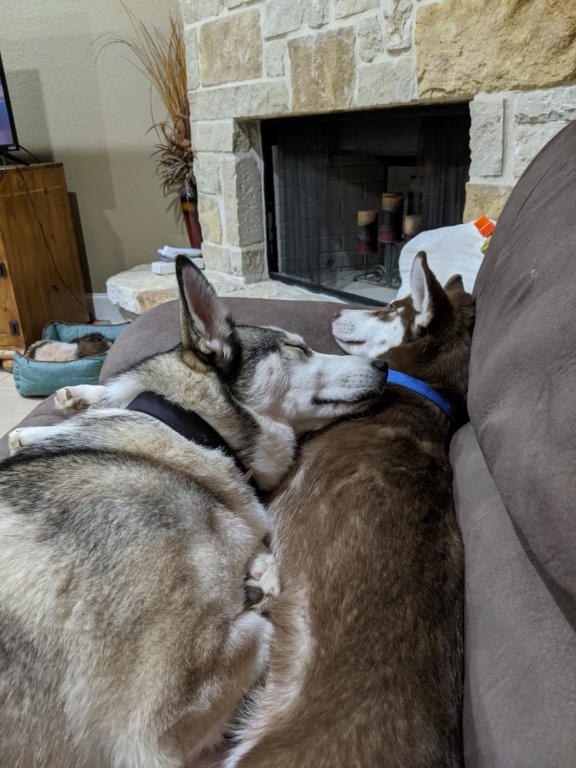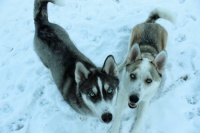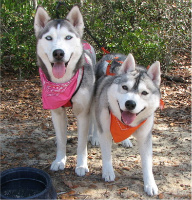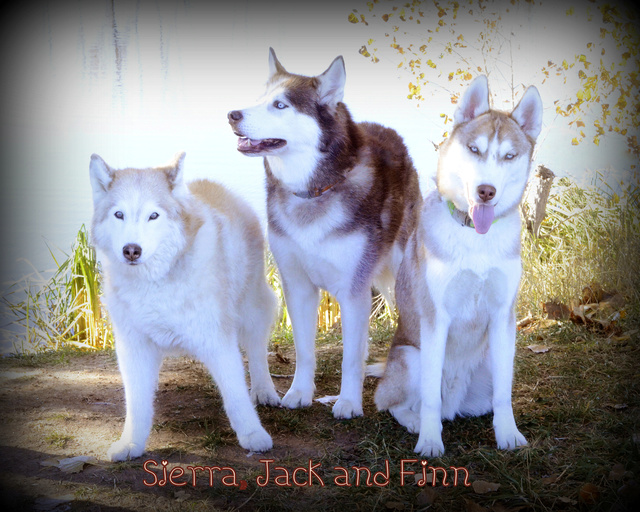| Husky of the Month |
Congrats Nikita, Archer, and Cheyanne,our November HOTM Winners!
Husky Cuddles!
  Thanks to all for this month's entries!
|
| Forum Rules | 1. Here we prefer clarity to agreement. Obviously not everyone is going to agree on a topic; here we prefer to talk out our differences in a respectful manner to ensure mutual understanding and respect.
2. Read the Stickies and Announcements. Each sub-forum may have specific rules which trump the Forum Rules in cases where there may be conflicting information. Read the rules of each board before you post so that you are clear on the expectations of the staff.
3. Respect ALL Staff and Admins. These people volunteer of their time and MUST be respected as well as their word adhered to. They are responsible for maintaining a free, open, clear and organized forum. Anyone found to be openly undermining any official ruling by a staff member will be warned.
4. Signatures: One picture only and no links. Images: To keep the forum looking neat and tidy, we ask that members insert just one picture only in their signatures. The picture should be no more than 200x500 pixels and should be of an appropriate subject, for example, your dogs and their names. Should you need assistance creating an appropriate signature, please PM an Admin and we would be happy to help! This is to ensure that signatures remain a welcome addition to our forum instead of a cumbersome distraction. Links: Hyperlinks in signatures--unless to a personal blog or photo stream of your dogs (like Flckr or Piscasa, for example)--are strictly prohibited. Please PM a staff member with any questions or concerns regarding this rule. |
| Rescue Spotlight |
Our current rescue spotlight is:
Delaware Valley Siberian Husky Rescue!

|
| Top Dog Website Award Winner! | |
|
| | Author | Message |
|---|
amcooke
Newborn


 Join date : 2012-03-12 Join date : 2012-03-12
Location : South Dakota
 |  Subject: training for mushing Subject: training for mushing  Thu Jul 05, 2012 1:52 pm Thu Jul 05, 2012 1:52 pm | |
| So we're going to try mushing this winter (if South Dakota gets snow this winter) but I have no clue where to start training wise. I do have their harnesses, lines, and supplies ordered from Alpine outfitter, and I also got a free sled, so I'm ready when it comes to supplies, I just have no clue where to start from there. Does anyone know of any good books? I tried to look for a mushing club/league here, but I can't find one.
My biggest question is how do you teach your dogs left and right? Just walking on the leash, or is there another way? |
|   | | SaraB
Rescue Subject Moderator

 Join date : 2010-09-09 Join date : 2010-09-09
Location : Deltona, FL
 |  Subject: Re: training for mushing Subject: Re: training for mushing  Thu Jul 05, 2012 1:58 pm Thu Jul 05, 2012 1:58 pm | |
| I can't find it now, but I remember reading an article about training on this site: http://www.sleddogcentral.com/beginners/welcome.htm
It does list some books in the beginners page. _________________ -Sara  |
|   | | jbealer
Husky Stalker

 Join date : 2009-05-29 Join date : 2009-05-29
Location : Denver, CO
 |  Subject: Re: training for mushing Subject: Re: training for mushing  Thu Jul 05, 2012 2:06 pm Thu Jul 05, 2012 2:06 pm | |
| Ashley,
if you look at the top of this form in the tool bar, click the search button and then type in mushing.
we have had a few talks on this topic and if you look through the post im sure all your questions can be answered.
but the short answer is, get the gear in put it on the pups and walk, run, bike, what ever you like to do get them used to the gear and then work on the commands you want to use so when the snow falls your ready. just don't always go the same way as they will just do the turns out of habit and not cause your telling them where to go.
its a ton of fun so good luck! its not just useful for mushing but for bike jorring, hiking, snow shoeing, ski jorring and what not. _________________  |
|   | | SaraB
Rescue Subject Moderator

 Join date : 2010-09-09 Join date : 2010-09-09
Location : Deltona, FL
 |  Subject: Re: training for mushing Subject: Re: training for mushing  Thu Jul 05, 2012 2:15 pm Thu Jul 05, 2012 2:15 pm | |
| Copied from Cindi from a different forum (the forum is pretty inactive now).
"This article was originally published in the Winter 2005/2006 issue of my "Dog & Sled" magazine. The version I am posting here is an unpublished 2007 update. There will be a completely revamped version in "Dog & Sled" this year but, as I have had interest from those who are thinking about getting into mushing, I thought I would go ahead and post the old version for all to read. I have learned a LOT since I wrote this but I think some of you will probably find useful information in it. The article is copyright 2007 Alice White.
LEARN TO MUSH!
Do you have an energetic dog? You can learn to mush with her! A lot of people are surprised that you do not have to have a large team of huskies, or even live where it snows, in order to participate in sled dog sports. You don't have to have a "traditional" sled dog (such as a husky or malamute). Other more unlikely breeds such as collies, retrievers, spaniels, bulldogs and hounds (hound/husky crosses are the current dog of choice for sprint racers) can be trained to mush. Years ago, a musher named John Suter ran the Iditarod with a team of standard poodles (the Iditarod Trail Committee later banned poodles and other non-northern breeds from racing), in 1930 Roland Lombard won a major race in New England with a team that included a Springer spaniel, and in 1912 Jack Holmes won a race in Alaska with a team of Irish setters.
Why should you and your dog learn to mush? Because it's fun and helps both of you stay healthy! Plus, it helps let "hyper" dogs release their excess energy. Instead of channeling that energy into destructive behaviors (the number one reason dogs are surrendered to animal control), they channel it into running and pulling! One only has to see a sled dog in action to realize how much he loves his "job."
The first thing you should do is to try to evaluate whether your dog is a good candidate for mushing. Both male and female dogs can learn to sled. A good sledding dog should be enthusiastic, energetic, tolerant of cold (if she is to mush on snow) and strong enough to pull.
Never attempt to mush a dog that has painful bone or joint problems.
Once you believe you have a good candidate for sledding, you need to acquire the right equipment. Here is a list of what you will probably need.
A HARNESS. There are dozens of different harnesses but there are several main styles. The most common are X-back or H-back Racing Harnesses. These harnesses are lightweight and have no buckles that might rub on your dog. They have a padded loop that slips around a dog’s chest and nylon straps that extend past the shoulders to the base of the tail. Here there is a loop where you can attach a leash or gangline.
Another harness that is steadily gaining in popularity is the so-called “Bikini-stlye" harness. This harness has fewer straps and only extends to the middle of the dog’s back. Prior to 2003, such harnesses were considered a thing of the past in sled dog racing circles. Recently, however, several mushers have started using them - with outstanding results. Mushers who use these harnesses say they may actually prevent injuries.
Stores like Wal-Mart and K-Mart often sell cheap nylon harnesses that are similar to the Bikini Harness. However, these types of harnesses generally do not have padding. It is best to buy a harness from a mushing supply company. For a list of suppliers, see links.
A COLLAR. Any type of collar is acceptable for your dog. Many mushers prefer a “working collar” that slips easily over a dog’s head and has a large metal ring. These rings are easy to grasp when wearing heavy gloves or mittens. However, a working collar is not a necessity. Your dog’s normal collar should suffice.
TWO LEASHES OR A COMMAND TRAINING LEASH. You will need one leash that is around six feet in length. You will also need a very short leash with a length of one or two feet. These leashes should be made of nylon and be able to withstand the dog’s constant pulling.
Another option is to buy a command training leash from a sled dog supply company. A command training leash has a short leash and a long leash attached to a single handle.
A BELLY BAND. This piece of equipment is useful, but not essential. It is not compatible with a bikini harness, but will prevent a dog from backing out of an X-back or H-back harness.
PAW PROTECTION. This is either "booties" - soft objects that slip on a dog’s paws - or sprays and creams that protect paws. If you are training on rough, icy snow or pavement, they are a must. However, if you are training on soft snow or dirt, they are not a necessity.
A SKIJORING BELT. This belt is not a necessity either but you can hook your dog’s leash to it. It will free your arms when you run with your dog during later training. These belts are very wide and have metal rings for attaching your dog’s leash.
A LIGHTWEIGHT LOG OR TIRE. This is a useful tool for teaching a young or inexperienced dog to pull.
A SCOOTER, BIKE OR TRAINING CART. You will need some sort of lightweight, wheeled object that your dog can pull after training progresses. You can buy carts built for just this purpose but a bicycle will work just as well, especially for a one or two-dog team. Mountain scooters are even better. They are safer and tougher than your average bike and are very popular with mushers running one or two dogs. Whatever you decide to use, it is absolutely essential that it have some type of brake.
A SLED. If you live where it snows, you can use a sled instead of a training cart. But even if you get a sled, it is best to have a warm weather alternative for training. For just one or two dogs, a kicksled is the best type of sled. Kicksleds were developed in Norway and were used as a winter-time scooter. Only recently have people begun using dogs to supply extra power. Kicksleds come in all shapes and sizes and are built out of many different materials. Most of them fold down for easy transportation and storage.
A PLACE TO TRAIN. It is best to train on a trail where there are few distractions. This way your dog will have your complete attention. You will need to start training on a simple trail that is straight or circles back to the starting point. Later you will need to train on a complicated system of interconnecting trails. Dirt trails are easier on a dog's paws but you can run on pavement if your dogs have adequate paw protection.
Here are the basic commands you will teach your dog.
LINE OUT - Stand facing down the trail with the leash taut.
HIKE - Go (“Mush” is never used in modern sledding).
WHOA - Stop.
GEE - Turn right.
HAW - Turn left.
COME AROUND - Turn around.
GEE OVER - Move to the right side of the trail.
HAW OVER - Move to the left side of the trail.
I will now explain how to train a dog. Let’s refer to the dog as “Timber.” If Timber is a puppy you may say “Hike” when he runs but don’t start difficult training until he is between six months and one year old. Be VERY careful mushing a dog under a year old since they are still developing. A dog is considered a puppy until two years of age and should not pull large amounts of weight before then. Some mushers train yearlings in their teams, but these dogs are in the middle of a team of older, stronger dogs so they share the weight of the sled and musher. This certainly doesn't mean you should not let a yearling dog pull you on a scooter or bike though. It just means you should be extra careful and assist as much as possible by kicking or peddaling.
The first thing you will need to do is to get Timber used to wearing a harness. Let him wear it around the house for a while each day.
After he is used to the harness, take him to the simple trail. Clip the long leash to his collar and the short leash to his harness. Stand behind him, hold the short leash taut and say “Line Out!” If Timber tries to come back to you, say “No!”, gently tug the long leash forward until he is back in the correct position and repeat the “Line Out!” command. If he obeys, tell him (in a very happy voice) that he is the most wonderful dog that every lived and is the smartest, most intelligent animal on the planet. If he tries to come back to you, repeat your previous correction. Dogs are smart and will quickly learn that lining out makes good things happen. This method is known as “positive reinforcement” and will be the basis of all your training.
After your dog has learned the “line out” command (this may take anywhere from a few minutes to a few days) you are ready to begin running.
With Timber on line out, stand behind him and, in an enthusiastic voice, say “Hike!”. As you say this, give a slight upward tug with the short leash and give a gentle forward tug on the long leash. The moment Timber moves forward, praise him and encourage him to continue. Once the two of you begin running, let him know he is a very good boy. Always make running fun.
Never go on long runs during these first few sessions. Keep it short. When you are ready to stop, say “Whoa!” and give a gentle backwards tug on both leashes. When Timber stops, tell him that he is a good boy.
At this point, you may need to turn around. Say “Come Around!” and pull backward on the long leash. Keep in mind that this command will confuse your dog at first. You have trained him not to turn around and now you are telling him to do just that. Encourage your dog to turn around and trot back the way you just came. After he makes the turnaround, say “Hike!” and continue back to your starting point.
If something distracts Timber, say “On By!” and encourage him to keep going. Sometimes dogs have to stop and go to the bathroom. Timber should be allowed to stop long enough to relieve himself but should learn to continue immediately afterwards. Stopping to simply sniff is unacceptable behavior and can generally be prevented by teaching the “On By!” command.
Go on a run at least three times a week. Keep on working for as many weeks as it takes to teach Timber the basics of mushing. He should learn to keep the short line taut when he runs, to come around, line out, run or stop when you tell him. And he should learn to enjoy it. Eventually, you will not need the long leash.
Now you can begin training on your more complicated trail. Begin the run like any other until you come to a fork or turn-off in the trail. If you wish to go to the right, say “Gee!” and gently tug the long leash to the right. If you wish to turn to the left, say “Haw!” and gently tug the long leash to the left. Do this for every turn you come to and don’t forget to praise Timber each time.
This part of training can sometimes get tedious. If it gets frustrating, take a break for a few days and run on the simple trail without using the “gee/haw” commands.
It may take a long time, but, with continual positive reinforcement, most dogs will eventually learn new commands.
Once you and your dog have mastered “gee/haw“, you can teach Timber the more complicated “Gee Over!” and “Haw Over!”. These are not essential commands, but they are useful if you ever need to let another person pass.
It is best to start this training on your simple trail. Run Timber along the trail and say either “Gee Over!” if you want to move to the right side of the road or “Haw Over!” if you want to movie to the left side. With the long leash, give a slight pull in that direction. If Timber tries to turn off the trail, you may wish to use the “On By!” command.
This will probably be difficult for both you and Timber. Timber must learn to differentiate between “Gee!” and “Gee Over!”. You must learn to be patient with him. If you are in a bad mood, your dog will immediately pick up on it and this will probably affect the entire run. Conversely, it is quite possible that you will learn to subconsciously pick up on your dog’s moods. If you do, pay attention to them. They may tell you whether something is bothering Timber. A good musher can often pick up on little signs and anticipate problems.
Once Timber has mastered the basic commands, try running with just the long leash attached to his harness. You may wish to attach the leash to a skijoring belt so that your hands will be free.
Do everything just as you did on your previous runs. If Timber has learned to take commands without any tugging with the long leash, this running should be no problem.
Now you can start to increase the distance you run. However you should never run very long distances when it is hot. What constitutes hot depends on your geographic location. If you are in the South, temperatures 40°f. or warmer are considered too hot for strenuous running. If you are in the North, temperatures above 30°f are considered too hot. Start increasing the length of your runs as the temperatures decrease in the Fall.
Now you may wish to start training with a cart, scooter, bike or (if there is snow) sled. At first Timber may be leery or even frightened of what appears to be a large inanimate object chasing him. Introduce the sled or cart slowly. Put it in the house or in a pen and allow Timber to come and sniff it. Make sure it cannot fall over and scare him.
If possible, have a friend bike, sled or cart (without a dog) along while you run on a training run. This will get Timber used to seeing and hearing the object while he runs.
The next step, of course, is for him to pull it. Start the run like any other but, instead of hooking a long leash to your belt, hook a gangline to the sled, bike or cart. Hook Timber to the gangline’s other end and tell him to “Line Out!”. Then climb onto your training equipment and yell “Hike!”. At the moment Timber begins moving forward, push the equipment forward yourself. Make sure not to run into Timber as this will frighten him.
Just move along behind him and encourage him to keep going. Tell him what a good sled dog he is.
Eventually, if everything goes well, you will be able to go out, hook Timber up and enjoy the ride.
POSTSCRIPT
Since I wrote the article "Training A Sled Dog" I trained my current husky, Calypso, using a method that differs from what I wrote about. Calypso was such a high-energy puppy that she needed to run at least twice a day - even at nine weeks of age. Since she was too young to really start training for "line out," I just ran along beside or slightly behind her. At four months of age, Calypso and ran one mile with me in the 2005 Dogs Across America relay. Obviously, at her age she didn't pull anything but that didn't stop us from running canicross.
When she was about six months old, I let Calypso pull a small, lightweight piece of wood. She would pull it at a lope for about half a mile. Over time, I increased the amount of weight she pulled. That Fall, when she was over a year old, I hooked her up to a scooter. She knew "hike" and "whoa" by that point, and was starting to realize what "on by" meant but she did not know "line out," or "gee/haw".
Obviously there are as many methods of training dogs as there are dogs. My methods have been adapted from a wide variety of sources and there is much more information that what I can put on a web page. Sometimes training must be tailored to fit the particular dog you are working with. Below are some reccomended books:
MUSH! A Beginner's Manuel Of Sled Dog Training. By the Sierra Nevada Dog Drivers. This book is a classic and was far, far ahead of its time. One of the best all-around books available on the subject of sled dog training.
Training Lead Dogs. By Lee Fishback. This book is dated but still has a large quantity of good information.
Skijor With Your Dog.
So there it is - my method of training sled dogs. It worked well for Aspen and me and I hope it will work well for you.
Good luck and happy trails.
Copyright 2007 Alice White/Dog & Sled" _________________ -Sara  |
|   | | shaina&indy
Teenager


 Join date : 2011-12-01 Join date : 2011-12-01
Location : Jackson, TN
 |  Subject: Re: training for mushing Subject: Re: training for mushing  Thu Jul 05, 2012 8:38 pm Thu Jul 05, 2012 8:38 pm | |
| Very helpful read, Sara. I was planning on training my two to do the same once Rebel is old enough  |
|   | | Sponsored content
 |  Subject: Re: training for mushing Subject: Re: training for mushing  | |
| |
|   | | |
Similar topics |  |
|
| | Permissions in this forum: | You cannot reply to topics in this forum
| |
| |
| | Latest topics | » My Old Girl is having trouble moving around…
 by aljones Mon Nov 18, 2024 3:23 pm by aljones Mon Nov 18, 2024 3:23 pm
» A day in the life
 by amymeme Mon Nov 18, 2024 3:11 pm by amymeme Mon Nov 18, 2024 3:11 pm
» Summer Time and the ....
 by Lostmaniac Fri Nov 15, 2024 12:30 am by Lostmaniac Fri Nov 15, 2024 12:30 am
» Squirt mystery illness and xrays
 by Lostmaniac Tue Nov 12, 2024 11:53 pm by Lostmaniac Tue Nov 12, 2024 11:53 pm
» The Desert Pack
 by Lostmaniac Thu Oct 31, 2024 2:19 am by Lostmaniac Thu Oct 31, 2024 2:19 am
» Dasuquin for the win!
 by Lostmaniac Mon Oct 28, 2024 9:09 pm by Lostmaniac Mon Oct 28, 2024 9:09 pm
» Hi new here
 by Lostmaniac Wed Oct 23, 2024 12:58 am by Lostmaniac Wed Oct 23, 2024 12:58 am
» Dog Attacked and Killed at Apex Park, Golden, CO
 by Lostmaniac Tue Sep 24, 2024 1:19 pm by Lostmaniac Tue Sep 24, 2024 1:19 pm
» Recall Information
 by aljones Tue Sep 24, 2024 11:20 am by aljones Tue Sep 24, 2024 11:20 am
» Whining after anesthesia
 by Lostmaniac Wed Sep 18, 2024 10:20 pm by Lostmaniac Wed Sep 18, 2024 10:20 pm
» Hello from Hiro
 by Lostmaniac Sat Sep 07, 2024 12:58 am by Lostmaniac Sat Sep 07, 2024 12:58 am
» Eye change help
 by amymeme Wed Sep 04, 2024 4:33 am by amymeme Wed Sep 04, 2024 4:33 am
» 2 year old Husky has mouth sores and patch on leg
 by Bigdog2 Sat Aug 10, 2024 12:48 pm by Bigdog2 Sat Aug 10, 2024 12:48 pm
» Why do other dog's dislike my husky?
 by Bigdog2 Fri Aug 09, 2024 10:38 pm by Bigdog2 Fri Aug 09, 2024 10:38 pm
» Need advice on best way to introduce new puppy to our 8 year old male husky
 by aljones Fri Aug 09, 2024 3:08 pm by aljones Fri Aug 09, 2024 3:08 pm
» Pending renewal or deletion
 by jbealer Thu Aug 01, 2024 1:35 pm by jbealer Thu Aug 01, 2024 1:35 pm
» Inflammatory Bowel Disease?
 by amymeme Wed Jul 31, 2024 3:34 pm by amymeme Wed Jul 31, 2024 3:34 pm
» URL Expiring. Do we renew?
 by ddvora Tue Jul 23, 2024 8:06 pm by ddvora Tue Jul 23, 2024 8:06 pm
» Hypothyrodism?
 by TwisterII Mon Jul 22, 2024 10:35 am by TwisterII Mon Jul 22, 2024 10:35 am
» Infection & Possible Tumor on Paw Pad. Help plz. Pictures Included
 by aljones Thu Jul 18, 2024 10:58 pm by aljones Thu Jul 18, 2024 10:58 pm
|
|






